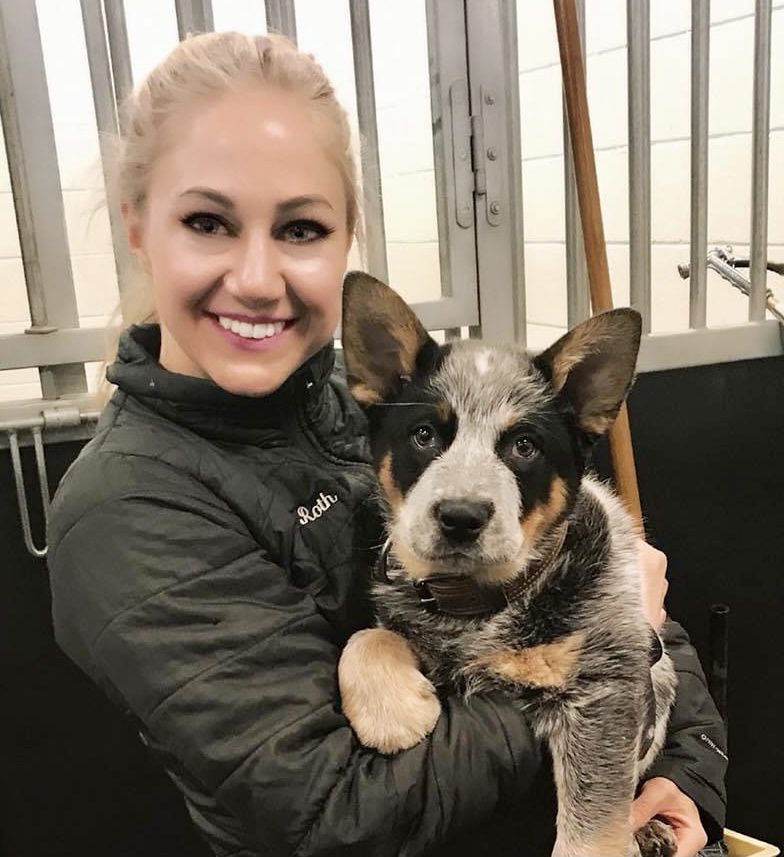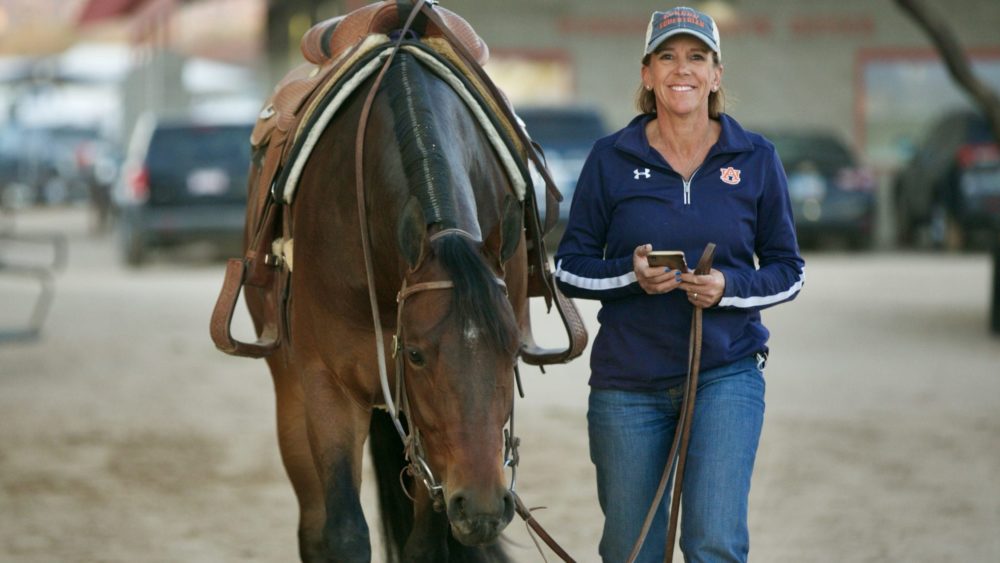Everyone in the horse business knows, keeping aging horses sound and healthy can be an investment in both time and money. Every performance horse has important care components: shoeing, nutrition, training, etc. Horses with no apparent problems need routine maintenance to prevent future issues but, special considerations for aging equine athletes are often necessary.
Use these insights from leading horsewomen Deanna Searles of Circle S Ranch, Dr. Alison Roth of Athletic Equine Veterinary Services, and Hillary Roberts of Capital Quarter Horses to maintain longevity in your older performance horses.
Deanna Searles, Circle S Ranch
 AQHA Professional Horsewoman Deanna Searles of Circle S Ranch says it takes a team of individuals to keep your performance horse healthy and showing. Searles suggests multiple ways to keep aging horses at the top of their game.
AQHA Professional Horsewoman Deanna Searles of Circle S Ranch says it takes a team of individuals to keep your performance horse healthy and showing. Searles suggests multiple ways to keep aging horses at the top of their game.
Performance horses should be on a regular hoof care schedule. Some older horses may need extra care with shoeing. Every performance horse will have different needs, especially the veterans. Your farrier should be willing to work with your veterinarian to solve any issues about hoof care. Searles discussed the importance of a good farrier and a farrier that “cares about each horse’s well-being.”
In addition to hoof care, older performance horses occasionally need joint injections, Searles says. Joint injections can treat lameness or be a type of proactive management. There are three types of FDA-approved injectable joint therapies in horses: intra-articular (IA), intravenous (IV), and intramuscular (IM). Depending on a horse’s use, soundness problems, and which/how many joints are affected, your veterinarian may prescribe none, one, or a combination of these prescription medications for joints. Joint injections are not a cure-all, so trust your veterinarian to decide when joint injections may benefit your horse.
As a protective measure, consider using joint supplements even if your horse shows no signs of joint problems. For example, Searles provides joint supplements for their horses who are being used, “We use joint & hoof coat supplements through SmartPak, which has made it very simple to individualize if needed. Additionally, we use Summit Joint Performance twice a month.”
Alternative methods of care, such as acupuncture and chiropractic work, can also be beneficial for older horses. Searles uses both methods in their routine for their performance horses. In addition, equine acupuncture is commonly incorporated in treating several conditions, especially musculoskeletal disorders and back pain.
Acupuncture can be an excellent supplemental treatment for horses with gastrointestinal disorders, neurological disorders, and other chronic issues such as heaves (COPD, RAO, asthma), anhidrosis, uveitis, Cushing’s disease, and more.
Chiropractic treatments for horses consist of a controlled force applied to a specific anatomical region to cause a therapeutic response. For example, joints can become restricted in their normal range of motion, but can be corrected with an adjustment. Any adjustment aims to restore the optimal range of motion to that joint, which will successively lessen inflammation and pressure on the surrounding nerves and soft tissue.
Nutrition, oral supplements, and an exercise plan are all imperative for maintaining an older performance horse. However, you must understand the nutritional needs of your specific horse and know what that entails to keep them at a healthy weight. Allowing a horse to become overweight puts added strain on his joints and connective tissue. Horses can also develop metabolic diseases such as Cushing’s disease, and, for this case, Searles suggests a low carbohydrate diet.
Keep in mind; an unfit horse is more susceptible to injury than one in better condition. Therefore, Searles suggests, “Keeping older horses fit is very important by moving them every day, whether it’s turning them out, putting them on the walker, ponying them with another horse, longline, or riding.”
Therefore, setting up a realistic exercise program and building or maintaining fitness is ideal for all horses, young or old. To prevent potential problems, Searles advises, “Try not to push the young horses more than they can handle. Give them time to grow and mature. Each horse is unique and common sense is a must.”
Alison Roth, DVM, Athletic Equine Veterinary Services
 Dr. Alison Roth is an equine sports specialist operating an equine mobile clinic. Dr. Roth stated the most common issue she sees among older performance horses is osteoarthritis. Osteoarthritis (OA) is a chronic, progressive, painful degeneration of the cartilage lining the ends of long bones inside joints and the underlying bone and soft tissues. In performance horses, we often think of OA affecting the joints in the limbs such as hocks, knees, stifles, and fetlocks. Dr. Roth notes, “Adequan and Pentosan are great products to help maintain healthy joints in older athletes.”
Dr. Alison Roth is an equine sports specialist operating an equine mobile clinic. Dr. Roth stated the most common issue she sees among older performance horses is osteoarthritis. Osteoarthritis (OA) is a chronic, progressive, painful degeneration of the cartilage lining the ends of long bones inside joints and the underlying bone and soft tissues. In performance horses, we often think of OA affecting the joints in the limbs such as hocks, knees, stifles, and fetlocks. Dr. Roth notes, “Adequan and Pentosan are great products to help maintain healthy joints in older athletes.”
Loss of athletic performance is a common early sign of underlying injury, and the changes are often subtle. Performance evaluations can help determine issues that may not be obvious. Dr. Roth first palpates the entire horse looking for any heat, swelling, sensitivities, or increased digital pulse. She will then review the horse’s movement, looking for lameness and gait symmetry, while leading the horse in hand, working on the longe line, and being ridden under saddle.
Additionally, Dr. Roth suggests regular check-ups with a sports medicine veterinarian to catch anything before it becomes a significant problem.

Dr. Roth emphasizes regular farrier work, maintaining fitness, and proper nutrition among older performance horses. Farriers play a significant role in your horse’s health. She encourages radiographs several times a year to ensure correct angles and balance in the horse’s legs and hooves. Keeping horses active with exercise and turnout is essential in their later years. Dr. Roth said, “A great and consistent work program is a huge part of any athlete’s care, and it’s important to all horses.”
Lastly, older performance horses can have specific nutritional requirements. Some may have difficulty maintaining muscle over their topline, and Dr. Roth suggests a topline balancer to help round out their dietary needs. Dr. Roth advises low starch performance feed and senior feed for veteran performers.
To help prevent soundness issues, Dr. Roth recommends “treating problems with biologics, never over-injecting problem areas, adequate rest, and use of proper imagining such as radiographs, ultrasounds, and MRI’s to confirm all problems.”
Hillary Roberts of Capital Quarter Horses LLC
 Hillary Roberts, business and stallion manager of Capital Quarter Horse LLC, discussed their team’s routine to keep veteran horses in the show pen.
Hillary Roberts, business and stallion manager of Capital Quarter Horse LLC, discussed their team’s routine to keep veteran horses in the show pen.
“Just like any athlete, horses get tight, sore, and stiff from time to time,” Roberts says. “Especially the veterans that spend lots of time on the road. We do a few things to make sure our horses look and feel their best at all times; staying consistent and on schedule with your farrier and veterinarian is an important component to horse show soundness. We often have our vet evaluate the horses before we leave for a show to be sure they are at 100% before departure.”
Proper nutrition for older performance horses is imperative, and each horse will be different. In general, good nutrition is still based on the horse’s requirements and meeting those requirements. Roberts believes starting performance horses in the very beginning and maintaining proper nutrition throughout their lives is critical.
Roberts stated, “We use Purina feeds and Dac products for our entire show string, as well as mares, babies, and everything out in the pasture. Purina has been the best for years, and we are proud to feed a product we trust to have the absolute best ingredients and results during the all-important growth stages for a young horse.”
Travel, competition, and new surroundings influence the horse and can hurt immunity, so having a properly balanced diet is vital for equine athletes.
In addition, minerals and vitamins are essential nutrients for all horses. You can provide your horses the best possible feed and nutrition, but sometimes they still experience mineral and vitamin deficits that cause adverse health consequences.
Roberts says, “Feeding Dac is a great way to be sure your horse is getting all the key vitamins and minerals he needs that he may be missing in his regular feed program. In addition, a few of our older horses receive the LQ-HA joint supplement to help keep their joints lubed up and comfortable. Feeding the right products for all stages of life is vital to maintaining a sound, strong show horse with the longevity to enjoy a long show career.”
Along with farrier and veterinary care and proper nutrition, Roberts suggested additional treatments during shows. For example, Roberts said, “Treatments like saltwater therapy and Magna Wave therapy can reduce inflammation and tension and help the older horses stay at their best.”
Salt therapy can improve breathing by clearing mucus and dissolving bacteria and pollutants in the respiratory tract. Ultimately, lung inflammation can be reduced, mucus will thin out, lung function will improve, and breathing passages will open.
Dry salt can also help reduce the recurrence of irritating skin conditions. Salt helps to treat overall inflammatory responses. Salt micro-particles reduce swelling and ease inflammation throughout the horse’s body.
Magna Wave PEMF (Pulsed Electro-Magnetic Field) therapy can help regenerate damaged or diseased tissue. Circulation is improved, and during treatment, the Lymphatic system is stimulated to clean damaged areas and detoxify the body. Magna Wave can also increase blood oxygen at the cellular level. Lastly, Magna Wave is particularly effective in relieving deep muscle soreness. The therapy is non-invasive, and no medication is required as a pretreatment for therapy.
Concluding Thoughts
Pay attention to your horse. Along with routine care and special treatment and nutrition, look for cuts, swelling, or tender spots. Have a veterinarian evaluate and treat injuries promptly. Pick out your horse’s hooves, especially before exercise, and look for chips, cracks, heat, or discolored spots that may indicate bruising. Keep an eye out for irregular stride length or head-bobbing as the horse moves, and ask a veterinarian for advice on these indications of pain or lameness. Stay vigilant with your daily care and schedule regular vet exams to give your aging equine partner the best chance to enjoy his golden years.








